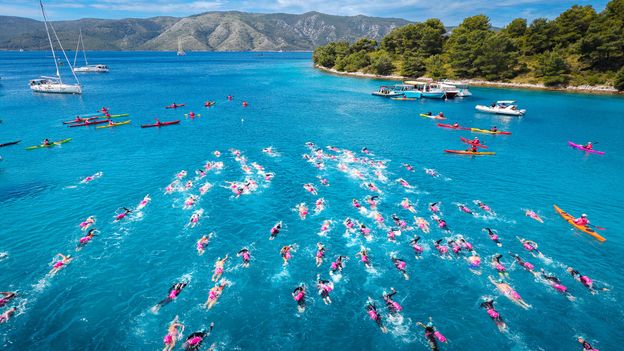In an era dominated by screens and sedentary lifestyles, a growing number of travelers are seeking more than just relaxation on their vacations. They’re craving challenge, transformation, and a deeper connection with themselves and the world around them. This has led to the rise of endurance sport as the new escape, where pushing physical and mental limits becomes the ultimate goal. From swimming across the Croatian coastline to running through the Sahara Desert, these adventure travelers are trading beachside cocktails for grueling tests of resilience.
This article explores the burgeoning trend of endurance-based holidays and the reasons behind their increasing popularity. We’ll delve into the transformative experiences reported by participants, the economic and cultural impact on host destinations, and the psychological factors driving individuals to seek out these extreme adventures. Get ready to discover why endurance sport is not just a vacation, but a powerful journey of self-discovery.
UltraSwim Croatia: A Swim of Self-Discovery
Imagine swimming 3km from Cape Pelegrin, a headland on Croatia’s Hvar island, across an open water channel to Palmižana. The water is choppy, and the destination seems distant. After reaching the other side, there’s another 5km along the Pakleni Islands’ coastline, with hidden coves and pine-fringed bays. This is UltraSwim 33.3, a four-day adventure covering 33.3km of Croatia’s coastline, equivalent to swimming the English Channel.
Mark Turner, the founder, aimed to create an event that blends racing, challenge, and adventure. He envisioned a challenge for those aged 40 to 60 who desire adventure, comfortable accommodations, good food, and regional exploration. Unlike the often unpleasant experience of swimming the English Channel, UltraSwim offers the same achievement in clearer waters, stunning surroundings, and with a glass of wine awaiting at the finish line.
“I wanted to create something that’s a cross between a race, a challenge and an adventure holiday,” said founder Mark Turner. “There’s a generation – people aged 40 to 60 – who still want that challenge, but also want to stay in a nice hotel, eat well, maybe bring their partner along and explore the region.”
The Growing Trend of Endurance-Based Travel
UltraSwim exemplifies the growing trend of endurance-based travel. Rather than typical relaxation, travelers now seek to push their limits. Examples include the 171k ultramarathon around Mont Blanc, the 250km Marathon des Sables across the Moroccan desert, and the 220km cross-country skiing through Finland’s Arctic Circle.
Alison King, a 56-year-old landscape architect, participated in the Ultra 33.3 swim in Croatia, seeking more life after two decades of raising children. Despite initial doubts, she completed the 12km swim, describing it as a “reset.” This sense of transformation is typical among ultra-endurance participants. The pain and effort lead to near-spiritual experiences.
“It wasn’t just a holiday. It was a reset,” says Alison King, a 56-year-old landscape architect from London.
Marathon des Sables: A Test of Mental Fortitude
Gemma Morris, a 41-year-old private jet flight attendant, completed the Marathon des Sables, a 250km ultramarathon in the Sahara. She describes it as the “best and worst week of my life,” filled with extreme highs and lows. Despite brutal heat and minimal living conditions, the landscape’s magic, the sunrises, silence, and starry skies, offered a unique sense of solitude and appreciation for the smallest things.
These excursions, once niche, are now mainstream. UltraSwim anticipates 600 participants from 38 countries in 2025, with plans to expand. The UTMB World Series hosts 200,000 runners across 50 annual events. The Race Across France cycling event grew from 300 participants in 2021 to 1,400 this year. Swimrun events, a mix of trail running and open-water swimming from Sweden, are also rapidly expanding.
Economic, Social, and Cultural Benefits
Ultra sporting events significantly benefit host countries economically, socially, and culturally. Michael Lemmel, co-founder of the ÖTILLÖ Swimrun World Series, notes that an event with 250 people can generate €50,000 in food and accommodation revenue. These events attract visitors who value nature and outdoor experiences, enriching the local community.
Hvar, once known for its party scene, is embracing this new identity by hosting cycling camps, trail running events, and long-distance swims. Iva Belaj Šantić, director of the Hvar Town Tourist Board, emphasizes that endurance events extend the tourist season, attract engaged visitors, and inspire the local youth.
“Endurance events help extend the tourist season and attract more engaged visitors,” said Iva Belaj Šantić, director of the Hvar Town Tourist Board.
The Psychological Perspective
Adventure psychologist Paula Reid believes the desire for ultra-sport holidays has a biological basis. She describes these holidays as an “evolutionary reset,” explaining that humans evolved to hunt and gather over long distances and are biologically built for discomfort and challenge. Modern life, being physically undemanding, necessitates these challenges for growth.
Endurance travel reshapes and restores individuals. It allows people to see new landscapes and perceive themselves differently within them, a reward greater than any beachside cocktail. The shared fatigue, handshakes, laughter, and the promise of food and wine create lasting memories. Traveling through and working for a place enhances its value and memorability.
Conclusion: More Than Just a Vacation
Endurance sport is transforming the travel landscape, offering more than just a break from routine. It provides a pathway to self-discovery, resilience, and a profound connection with nature and oneself. Participants are not merely tourists; they are active explorers pushing their limits and redefining their capabilities.
As we haul ourselves out of the water at the end of the final stage in Hvar Town, the Sun is setting behind the harbour walls. My shoulders are sore and salt is crusted on my skin. But there is something quietly triumphant in the shared fatigue, the congratulatory handshakes, the laughter and the promise of grilled fish and red wine just up the hill. We traveled through a place, and worked for it. And somehow, that makes the place – and the memory of it – all the more lasting.

Leave a Reply